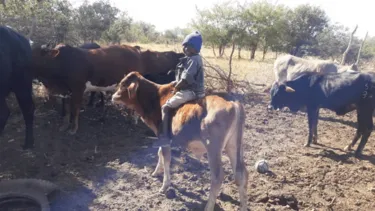Born with HIV: Providing care for Zambia’s youth
In Zambia, Project HOPE is fighting the HIV epidemic by supporting vulnerable children and their caretakers with vital health, education, livelihood, protection, and other social services.

On a February afternoon in rural Chongwe, twelve-year-old Kelvin arrived at the local health clinic to pick up his medication for HIV.
He was being switched to second-line treatment — treatment that is given when initial treatment either doesn’t work or stops working. When a community case worker partnering with Project HOPE noticed he was alone, without an adult, his case was given extra attention. He explained he was living with his great grandmother, and a home visit was scheduled to meet with her.
It soon became apparent that Kelvin was suffering from depression. He was struggling to accept his HIV status, and felt like he was being treated differently because he was the only member of his family staying with his great grandmother while his mother was away at nursing school. His siblings were living in Lusaka with their aunt.
In secret, he had stopped adhering to his treatment. Every time he was given his medicine he would hide it under his bedroom carpet, until one day his grandmother discovered it while cleaning.
When she took him for a health consult, tests revealed a high viral load. Kelvin had also developed tuberculosis and a lung infection, and quickly began falling behind in school as a result. In response, his local health clinic connected him to the treatment, counseling, and support he needed to get back on track, with help from Project HOPE.
An epidemic of dangerous consequence
Kelvin’s story, the story of a young boy trying to come to terms with life with HIV, is one of thousands. For over 30 years, the HIV epidemic has ravaged Zambia, leaving few families unaffected and untouched.
The national HIV prevalence rate is 11% among adults. In 2021, an estimated 1.3 million people in the country were living with HIV/AIDS — the majority of them women over the age of 15. More than 600,000 children and adolescents have been orphaned by HIV/AIDs, and nearly 1 in 3 households are caring for children or adolescents who have lost parents to HIV.
Despite significant progress over the past six years in terms of status awareness, treatment adherence, and viral suppression, the epidemic continues to be one of Zambia’s greatest challenges and the leading cause of death.
In partnership with the Centre for Infectious Disease Research in Zambia, Project HOPE is working to mitigate the impact of HIV and improve the health and well-being of vulnerable children and adolescents across Zambia.
Reaching families with hope
Since October 2020, Project HOPE has been supporting young people and their caregivers through the USAID PEPFAR program Empowered Children and Adolescent Program III (ECAPIII), reaching communities across seven provinces of Zambia with a collection of vital health, education, livelihood, protection, and other social services.
This includes improving access to health and HIV services, including antiretroviral therapy and adherence support, and increasing access to opportunities and income for caregivers in order to boost household economic security. We’re also improving child protection and the prevention of gender-based violence, and working closely with school boards, protection workers, and mothers groups to help children stay in school.
Over 61,000 vulnerable children and adolescents and caregivers were reached in the first year of the program, including Kelvin.
All of our work is tailored to address the specific needs of individual children, households, and communities. For Kelvin, this support has been transformative. Upon discovery of his health conditions, the team assisted with transport to and from the hospital and enrolled him in adherence counseling. With continued counseling and regular home visits, his viral load dropped from 75,000 to 75, and when his great grandmother passed away, the team engaged his mother in his treatment plan. Kelvin is now healthy enough to attend school every day, progressing from one grade to the next, and has restored hope for a happy and healthy future.
“The ECAP III team has offered hope where there was no hope for my child,” says Kelvin’s mother. “Kelvin has moved from a high viral load to getting suppressed. Now I’m looking forward to him being undetectable.”



